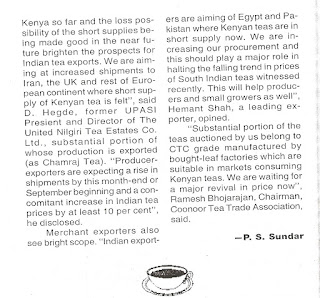FOR THE RECORD -- 13::
 ‘Global Tea
Digest 2015’, (GTD), the storehouse of statistical data on tea acreage,
production, yield, prices, exports, import and domestic consumption relating to
tea industry around the world, has come out.
‘Global Tea
Digest 2015’, (GTD), the storehouse of statistical data on tea acreage,
production, yield, prices, exports, import and domestic consumption relating to
tea industry around the world, has come out.
 “There is a high demand from exporters for GTD as these data help on deciding their intake
from India. We take pride in sharing GTD with exporters”, L C Singhania, Chairman, Coonoor Tea Trade Association, who
received the first copy, said.
“There is a high demand from exporters for GTD as these data help on deciding their intake
from India. We take pride in sharing GTD with exporters”, L C Singhania, Chairman, Coonoor Tea Trade Association, who
received the first copy, said.
GLOBAL TEA DIGEST 2015 RELEASED
BY P S SUNDAR
 ‘Global Tea
Digest 2015’, (GTD), the storehouse of statistical data on tea acreage,
production, yield, prices, exports, import and domestic consumption relating to
tea industry around the world, has come out.
‘Global Tea
Digest 2015’, (GTD), the storehouse of statistical data on tea acreage,
production, yield, prices, exports, import and domestic consumption relating to
tea industry around the world, has come out.
“The data
compiled in GTD are of great use to tea industry and trade for decision
making. They reflect the economic situation obtaining in current
tea with rising prices and consumption trends. These data post a
bright outlook for 2016”, Tea Board Executive Director C Paulrasu told me
after releasing GTD on Dec 22, 2015.
 “There is a high demand from exporters for GTD as these data help on deciding their intake
from India. We take pride in sharing GTD with exporters”, L C Singhania, Chairman, Coonoor Tea Trade Association, who
received the first copy, said.
“There is a high demand from exporters for GTD as these data help on deciding their intake
from India. We take pride in sharing GTD with exporters”, L C Singhania, Chairman, Coonoor Tea Trade Association, who
received the first copy, said.
“This is our
fifth annual edition. It contains 60 classified tables, 120
detailed tables and colourful graphs spread to 160 pages”, Rajesh Gupta, GTD
compiler, noted.
“The data
relate to black tea, green tea and instant tea around the globe”, N Sriram,
President, Global Tea Brokers (GTB), said.
“Details of
tea grades, tea tasting terminology and glossary are also included in GTD”, GTB
General Manager Senthil Kumar said.
“The GTD is
distributed free-of-cost as our dedication to tea industry and trade”, GTB
Executive Hariprasath added.
Besides the widespread statistical data on tea industry and trade, some facts about tea listed in the GTD are as fascinating as the very beverage.
Besides the widespread statistical data on tea industry and trade, some facts about tea listed in the GTD are as fascinating as the very beverage.
For instance, do you know that In Myanmar, people eat, not just drink,
tea?
“Fermented or pickled tea is a national delicacy of Myanmar. It is eaten as Tea Leaf Salad”, records Tea
Glossary section of GTD.
“We have recorded many less-known facts about tea production and drinking
round the world”, GTD Compiler Rajesh Gupta told me.
Chinese green tea from Zheijiang province is rolled into small
pellet-size ball and dried. So, it is
called ‘Gunpowder’. This tea’s colour is
also like gunpowder.
The 7th Duchess of Bedford gave birth to ‘afternoon tea’
drinking practice in the 19th century as she drank tea to stave off
hunger pangs between lunch and dinner.
Finger sandwiches, cakes or pasties accompanied the ‘afternoon tea’.
Chinese and Japanese tea mixed with stalk and dust and moulded into
bricks under high-pressure were carried by Asian travellers to drink tea on
their way and it was called ‘brick tea’.
‘Handkerchief tea’ got its name from large silk handkerchiefs which
Chinese tea growers used to collect their very tippy tea.
‘Chunmee tea’ is Chinese green tea resembling the shape of human eyebrow.
Tea transported on camel from China to Russia in the past was called
‘Caravan Tea’.
In Tibet, ‘Butter tea’ is boiled tea mixed with salt and soda, strained
into an urn containing butter and dried barley and churned. It is served is a basin with lumps of butter.
(response can also be sent to: pssundar.coonoor@gmail.com)















































